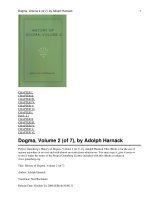beam propagation modeling of modified volume fresnel zone plates fabricated by femtosecond laser direct writing
Bạn đang xem bản rút gọn của tài liệu. Xem và tải ngay bản đầy đủ của tài liệu tại đây (896.35 KB, 7 trang )
Beam propagation modeling of modified volume
Fresnel zone plates fabricated by femtosecond
laser direct writing
Pornsak Srisungsitthisunti,
1
Okan K. Ersoy,
2,
*
and Xianfan Xu
1
1
School of Mechanical Engineering, Birck Nanotechnology Center, Purdue University, West Lafayette,
Indiana 47907, USA
2
School of Electrical and Computer Engineering, Birck Nanotechnology Center, Purdue University,
West Lafayette, Indiana 47907, USA
*
Corresponding author:
Received September 19, 2008; revised November 17, 2008; accepted November 17, 2008;
posted November 19, 2008 (Doc. ID 101731); published December 24, 2008
Light diffraction by volume Fresnel zone plates (VFZPs) is simulated by the Hankel transform beam propaga-
tion method (Hankel BPM). The method utilizes circularly symmetric geometry and small step propagation to
calculate the diffracted wave fields by VFZP layers. It is shown that fast and accurate diffraction results can be
obtained with the Hankel BPM. The results show an excellent agreement with the scalar diffraction theory
and the experimental results. The numerical method allows more comprehensive studies of the VFZP param-
eters to achieve higher diffraction efficiency. © 2008 Optical Society of America
OCIS codes: 320.7110, 050.1970, 130.3120, 000.4430, 050.1960, 070.2590
.
1. INTRODUCTION
The volume Fresnel zone plate (VFZP) is a focusing device
consisting of a number of Fresnel zone plate (FZP) layers
inside a transparent medium [1,2]. The FZPs are aligned
on the same optical axis and designed to focus light to a
single spot as shown in Fig. 1. By combining a number of
FZPs coherently, the VFZP can achieve much higher dif-
fraction efficiency than a conventional FZP. This is espe-
cially useful when an individual FZP can only be fabri-
cated with small diffraction efficiency. The VFZP can be
fabricated by femtosecond laser direct writing. This con-
cept was experimentally demonstrated with an eight-
layer modified VFZP, showing a maximum efficiency of
71.5% [2]. However, the performance of the VFZP is not
fully optimized. The overall diffraction efficiency of the
VFZP is determined by many factors such as the number
of FZP layers, fabrication parameters, VFZP design, etc.
The experimental study of VFZP shows that the efficiency
of the VFZP continues to increase up to a certain number
of FZP layers before it starts to drop [1,2]. Consequently,
it is difficult to predict the diffraction efficiency of the
VFZP, since light propagation by diffraction through 3D
VFZP structures is complicated. A numerical simulation
is necessary to study diffraction behavior of a VFZP. Un-
derstanding how light is diffracted through the VFZP will
help in predicting the VFZP performance and improving
the VFZP design.
Several numerical methods for diffractive optics simu-
lation are available, including scalar diffraction theory
[3], rigorous diffraction theory [4], fast Fourier transform
(FFT) methods [5], beam propagation method (BPM) [6],
finite element analysis (FEA) [7], finite-difference time
domain method (FDTD) [8], and so on. These methods
have different advantages and limitations for different
simulation conditions, such as near and far fields and
1D–2D–3D calculations, which affect the accuracy of the
results. In the case of the VFZP, the selected method must
employ small step propagation to enable simulation of
multiple diffractions through the FZP layers. The split-
step BPM can handle such a situation where the field ex-
periences
rapid modulation. In particular, the FFT-based BPM
(FFT-BPM) utilizes the Fourier transform to locally de-
compose the entire field into plane waves that are then
propagated forward in the spectral domain and corrected
at each step in the spatial domain [6,9]. The FFT-based
methods are preferable since they provide fast calculation
with high accuracy. When circular symmetry is available,
the Hankel transform (Fourier–Bessel) can be applied so
that the diffraction analysis becomes 2D ͑r,z͒ instead of
3D ͑x,y,z͒ [9]. The VFZP structure has cylindrical sym-
metry and can utilize the Hankel transform. In this work,
the Hankel transform BPM was developed to study the
performance of modified VFZPs. The simulation results
closely matched with the experimental results, allowing a
better understanding of the influence of the VFZP design
parameters.
This paper is organized as follows: the detailed descrip-
tion of the Hankel transform method and its implementa-
tion for VFZP are discussed in Section 2. Section 3 evalu-
ates the accuracy of the Hankel transform results by
comparison with the scalar diffraction theory. Section 4
discusses the behavior of light diffraction by a VFZP. The
VFZP simulation results are discussed and compared
with the experimental results in Section 5, followed by
conclusions in Section 6.
188 J. Opt. Soc. Am. A/Vol. 26, No. 1/January 2009 Srisungsitthisunti et al.
1084-7529/09/010188-7/$15.00 © 2009 Optical Society of America
2. LIGHT DIFFRACTION SIMULATION BY
THE HANKEL TRANSFORM BEAM
PROPAGATION METHOD
Wave propagation through cylindrically symmetrical
structures can be simulated by using the Hankel trans-
form and its inverse to convert back and forth between
the spatial domain and the frequency domain. First, the
input field is transformed to the spectral field, before
propagating to the image plan by multiplying by a propa-
gation factor, exp͑2
jz
ͱ
1/
2
−͑f
x
2
+f
y
2
͒͒. Then, the spectral
field at the image plane is inverse-transformed back to
the spatial field. Mathematically, the inverse Hankel
transform has the same form as the Hankel transform,
making the conversion process easy to implement. The
Hankel transform of zero order and its inverse are given
by [9,10]
U͑
͒ =2
͵
0
ϱ
u͑r͒J
0
͑2
r
͒rdr, ͑1a͒
u͑r͒ =2
͵
0
ϱ
U͑
͒J
0
͑2
r
͒
d
, ͑1b͒
where J
0
is the Bessel function of the first kind of zero or-
der. The Hankel transform is essentially the 2D continu-
ous Fourier transform of a circularly symmetry function.
There are several methods for the numerical calcula-
tion of the Hankel transform. A quasi-discrete Hankel
transform (QDHT) developed by Guizar-Sicairos and
Gutiérrez-Vega (2004) assumes a finite frequency domain
and uses a transformation matrix to quickly compute the
Hankel transform as well as the inverse Hankel trans-
form [10]. The method approximates the input function by
sampling at positions proportional to the positions of the
zeros of a Fourier–Bessel function. In addition, the in-
verse Hankel transform with this method is energy pre-
serving as it can reconstruct the original wave field.
Hence, this method of Hankel transform computation pre-
vents energy loss, and thereby is suitable for field propa-
gation simulation. We utilized the QDHT method for the
zero-order Hankel transform.
In this work, the simulation of light diffraction through
the VFZP is analyzed in small steps along the propagat-
ing direction z, using the BPM method. Combined with
the Hankel transform, we refer to this method as the
Hankel transform BPM (Hankel BPM). This method is
also demonstrated by Guizar-Sicairos and Gutiérrez-Vega
[10]. First, a VFZP is designed by generating a number of
FZP layers in different axial locations. The design of each
FZP layer is different, depending on its location relative
to the overall focusing spot to combine light at the focus
[1,2]. Then, a number of radial and axial steps are chosen,
and the FZP profile at each layer is discretized with a ra-
dial step. The plane wave is converted to a spectral field
and then propagated step by step in the axial direction.
Only when the wave field is propagated through a FZP
layer is the complex field (amplitude and phase) con-
volved with the FZP profile. In the simulation model, the
FZPs are separated by a few propagation steps so that
light interacts with one FZP layer and propagates a few
steps before interacting with the next FZP layer, and so
on. The wave fields are stored at each propagation step.
For example, Fig. 2 shows the simulation model of a
three-layer VFZP. The model is developed in the cylindri-
cal coordinates. For simplicity, each FZP has uniform
thickness and results in phase modulation within a VFZP.
In addition, the radial extent of the simulation is about
twice the size of the VFZP radius and the light outside the
VFZP is blocked on the first layer. More importantly, to
avoid aliasing from the edge of the computational window,
it is necessary to apply zero padding at the edge (bound-
ary).
In the actual fabrication, the VFZP is fabricated inside
a medium such as fused silica, so light travels through
two different media. A simulation can be performed by as-
signing the correct wavelength in fused silica
͑ / 1.46͒—the material used for fabricating VFZP [1,2]or
air during the corresponding propagation step. By apply-
ing different wavelengths, the refraction effect at fused
silica and air interface is taken into account. Arbitrary
phase and amplitude modulation can be introduced into
the numerical model through the complex-valued trans-
Fig. 1. (Color online) Example of a VFZP having four FZP
layers.
Fig. 2. Simulation model of a three-layer VFZP showing propa-
gation steps used by the Hankel BPM calculation. The actual
computational windows are twice the size of the maximum
radius.
Srisungsitthisunti et al. Vol. 26, No. 1/January 2009 / J. Opt. Soc. Am. A 189
missivity of the FZP. This allows partial phase FZP or am-
plitude FZP to be simulated. The Hankel BPM simulation
results confirm that a phase FZP has four times the effi-
ciency of the amplitude FZP, which agrees with the
theory.
The accuracy of the Hankel BPM depends on the num-
ber of sampling steps. We concluded that the radial sam-
pling step size should be smaller than the smallest outer-
most zone width to avoid nonnegligible error due to
discretization. The smaller the sampling step size is, the
more accurate the results that can be generated. On the
other hand, using a large number of radial steps costs a
significantly larger computational time. For a quick com-
parison, a 300-radial-step calculation took about 1.7 s on
a 2.4 GHz computer with 1 Gbytes of RAM, a 1000-radial-
step took 12.9 s, and a 3000-radial-step calculation took
103.3 s. As a result, we learned that 1000 radial steps
were sufficient for our far-field FZP simulation. The re-
sults are much less sensitive to the number of axial steps.
The advantage of the Hankel BPM is the ease of its
implementation and high numerical efficiency (i.e., com-
putation time per propagation step is small). However,
since the BPM method calculates the wave field in the for-
ward direction, it cannot resolve the reflection wave.
Since light reflection from a phase-type VFZP is negli-
gible, this is not a major issue. Simulation allows an ar-
bitrary VFZP design to be simulated, providing a useful
prediction for the VFZP performance. Furthermore, the
method can be extended to simulate noncircular struc-
tures by replacing the Hankel transform with the 2D fast
Fourier transform.
3. VERIFICATION OF THE HANKEL BEAM
PROPAGATION METHOD
In this section, the accuracy of the Hankel BPM method is
tested by comparing its results with the results of the sca-
lar diffraction theory. Light diffraction by a FZP can be
explicitly calculated by the Rayleigh–Sommerfeld (RS)
diffraction integral. Therefore, FZP diffraction by the
Hankel BPM can be verified by comparing it to the RS dif-
fraction result. The RS integral is given by [9]
U͑P
0
͒ =
1
j
͵͵
s
U͑P
1
͒
exp͑jkr͒
r
cos͑n
ជ
,r
ជ
͒ds. ͑2͒
where P
0
is a point in the observation plane, P
1
is in a
point at the initial plane, r
ជ
is the vector pointing from P
0
to P
1
, s is the enclosed surface, n
ជ
is a vector normal to the
surface, k is the wave vector, and is the wavelength. The
RS diffraction formula can evaluate the exact light field in
the far field for scalar diffraction. Normally, the RS inte-
gral is difficult to solve analytically without applying the
Fresnel or Fraunhofer approximation. Cao and Jahns
(2004) applied the far-field ͑fӷ͒ assumption, and evalu-
ated the analytical result for FZP focusing [3]. We modi-
fied the method by Cao and Jahns [3] to simulate differ-
ent types of FZPs. The RS method integrates each Fresnel
ring and combines the total field intensity at the focal
plane as follows:
U͑R͒ =
͚
n=1
N
U
n
͑R͒,
U
n
͑R͒ =
1
͵͵
A
n
f
2
exp͑jk
͒rdrd
, ͑3͒
where R is the radial location at the focal plane, N is the
number of rings, f is the focal length of a FZP, and
is a
function of optical path length given by
=͓f
2
+R
2
+r
2
−2Rr cos͑
−
͔͒
1/2
,
is the angle in the input plane, and
is the angle in the focal plane. U
n
is the focal intensity
from one FZP ring and U is the total focal intensity.
As discussed in our previous work [1,2], “central-ring”
FZPs were fabricated at each zone that have a uniform
width and were located at the center of each Fresnel zone.
The reasons are to reduce the time needed for fabrication,
to make fabrication more practical with robustness
against experimental errors, and to avoid zone overlap-
ping for high numerical aperture (NA) FZPs [2]. The re-
sults of the Hankel BPM and RS integral methods are
comparatively discussed for both the regular and the
central-ring FZPs. The simulation geometries of the regu-
lar and central-ring FZPs are shown in Figs. 3(a) and
3(b), respectively. Both types of FZPs contain 20 Fresnel
zones and have a focal length of 20 mm. The sizes of both
FZPs are 1.4 mm in diameter. The results of the RS
method are shown in Figs. 3(c) and 3(d). In Fig. 4, the con-
tour plots show propagation of the light intensity by the
Hankel BPM method. The gradient of the contour plots
has been reduced by plotting I
͑1/4͒
to clearly show the
propagating pattern. The axial intensity results from both
methods show very similar results for the regular and
central-ring FZPs. At the primary focus, the central-ring
FZP has about half of the intensity of the regular FZP, be-
cause of the missing portion in each central-ring zone.
Therefore, the efficiency of the central-ring FZP strongly
depends on the zone width.
The appearances of the higher order foci of the two
FZPs are different, and can also be used to verify the ac-
curacy of the Hankel BPM. In the regular FZP, the foci of
the even orders would cancel out completely due to sym-
metric counter phase shifts within one zone (destructive
interference), while the foci of the odd orders remain.
Therefore, the regular FZP only generates odd order foci
(at f/3,f/5, .), and the intensities of the foci decrease
rapidly as the number of orders increases. On the other
hand, the central-ring FZP does not fully cover the
Fresnel zones, and all the orders of foci remain with some
efficiency. The intensity at these higher order foci depends
on the zone width of the central-ring FZP. The central-
ring FZP has lower focal intensity because part of the en-
ergy goes to other higher order foci. The results suggest
that both the Hankel BPM and the RS integral method
correctly predict the higher order behavior as discussed
previously.
In summary, for one layer FZP, the Hankel BPM
method correctly predicts diffraction output of the regular
and central-ring FZPs. This suggests that the Hankel
BPM method is a suitable tool for FZP simulation, and is
extended to VFZP simulation in this work.
190 J. Opt. Soc. Am. A/Vol. 26, No. 1/January 2009 Srisungsitthisunti et al.
4. DIFFRACTION ANALYSIS OF VOLUME
FRESNEL ZONE PLATE
In this section the Hankel BPM is used to study diffrac-
tion by a VFZP (see Fig. 5). For the simplest case of a two-
layer VFZP, diffraction of light can be separated into
three beams as shown in Fig. 6. The first and second
beams are due to single diffraction by FZP1 and FZP2,
and they are combined at the focus spot as designed. The
third beam is a result of the first beam diffracted again by
the FZP2, and projected to another spot at a shorter dis-
tance than the focal length. This is equivalent to the fo-
cusing of a compound lens. A simple calculation using geo-
metrical optics can determine the location of the focusing
spot of the third beam. This location depends on the sepa-
ration of the two FZPs. The Hankel BPM simulation is ex-
pected to calculate all the diffractions including the light
spot due to multiple diffractions. Therefore, simulations
of single layer and two-layer central-ring VFZPs are per-
formed in order to compare the intensity of the primary
focus and the extra focusing spot. The simulation results
are shown in Fig. 6. While the intensity at the primary
focus of the two-layer VFZP doubles, the higher order foci
intensities are slightly decreased. This is because the
VFZP is designed for a phase matching condition at the
primary focus only. In addition, the simulation result
clearly identified the spot due to double diffraction at the
location as calculated by the compound lens focusing
method. We conclude that diffraction by the VFZP con-
sists of primary diffractions, and multiple diffractions and
the Hankel BPM simulated all the diffracted light cor-
rectly.
The spots created by multiple diffractions usually have
low efficiency. For example, if each FZP has 10% effi-
ciency, the efficiency becomes 1% by double focusing.
Thus, for a VFZP consisting of a larger number of FZP
layers, focusing due to multiple diffractions is negligible.
5. VOLUME FRESNEL ZONE PLATE
SIMULATIONS
A major purpose of VFZP simulation is to study how the
efficiency increase is associated with the number of FZP
layers and the amount of phase modulation applied at
each FZP layer. Diffraction efficiency can be calculated by
dividing the focal energy by the total input energy. Nor-
mally, the size of the focus is defined as
0
=0.61/NA,
where NA is the numerical aperture of the VFZP. There-
fore, the diffraction efficiency is given by
Fig. 3. (a) Regular FZP, (b) central-ring FZP, and light diffraction computed by the RS integral (c) the axial diffractions, (d) the radial
diffractions at the focal plane.
Srisungsitthisunti et al. Vol. 26, No. 1/January 2009 / J. Opt. Soc. Am. A 191
=
I
0
I
input
=
͵
0
0
Idr
͵
0
aperture
Idr
. ͑4͒
The regular VFZP and the central-ring VFZP designed
for 20 mm focal length, consisting of up to 20 FZP layers,
were simulated. These VFZPs are assumed to have uni-
form phase modulation at each FZP layer from 0.05
to
0.4
. Figures 7 and 8 show the relationship of the phase
modulation and the number of FZP layers on the diffrac-
tion efficiencies of the regular and central-ring VFZP, re-
spectively. Clearly, the number of layers that produces
maximum diffraction efficiency of a VFZP depends on the
phase modulation of each individual FZP. The lower the
Fig. 4. (Color online) Diffraction results calculated by Hankel BPM for (a) the regular FZP and (b) the central-ring FZP. The gradient
of the contour plots was reduced by plotting I
͑1/4͒
to clearly show the propagating pattern.
Fig. 5. Light diffraction by VFZP consists of single diffractions
(1,2) and multiple diffractions (3).
Fig. 6. Comparison of (a) the regular FZP and (b) the two-layer
regular VFZP to show the effect of double diffraction by the Han-
kel BPM. The phase modulation is 0.5
for each FZP layer.
192 J. Opt. Soc. Am. A/Vol. 26, No. 1/January 2009 Srisungsitthisunti et al.
phase modulation, the higher the number of layers re-
quired to reach the maximum efficiency. For example, in
the regular VFZP case, the small phase shift of 0.05
re-
quires more than 20 layers, while the phase shift of 0.4
requires only 4–5 layers to reach maximum diffraction ef-
ficiency. In general, the regular VFZP requires less num-
ber of FZP layers to achieve maximum possible efficiency,
since each regular FZP has higher efficiency than the cor-
responding central-ring FZP. Once the efficiency reaches
the maximum, more layers of FZP causes efficiency to
drop. Small phase modulation tends to achieve higher
overall diffraction efficiency. Therefore, the VFZP is an ef-
fective method in terms of improving efficiency when the
individual FZP is limited to small efficiency. A major con-
clusion is that it is possible to achieve high diffraction ef-
ficiency with the central-ring VFZP close to that of the
regular VFZP, and much higher than single regular FZP.
This central-ring VFZP method is competitive with mul-
tilevel phase FZP, yet has the advantage of easy imple-
mentation, for example, within glass volume media. Al-
though the regular VFZP can reach a little higher
efficiency, the fabrication time is much higher than the
central-ring VFZP, and is much more sensitive to fabrica-
tion errors. It is worth mentioning that the full width at
half-maximum (FWHM) of the central-ring VFZP is com-
parable to the FWHM of the regular VFZP. This indicates
that the focal spot size is a function of the NA, and the
central-ring VFZP can be used for high resolution focus-
ing.
The central-ring VFZP simulations also yield the fol-
lowing results, which are helpful for the design of the
VFZP:
• The amount of phase modulation is directly related
to individual FZP efficiency. The smaller the FZP effi-
ciency, the higher the VFZP efficiency can reach. How-
ever, it is not practical to use more than 20 layers to get
slightly higher efficiency.
• Increasing the number of zones improves the indi-
vidual FZP efficiency since a larger amount of light is dif-
fracted, and it requires fewer FZP layers to achieve maxi-
mum VFZP efficiency. The effect of the number of zones is
similar to the effect of phase modulation.
• The focal length has an interesting effect. In Fig. 9,
central-ring VFZPs with different focal lengths were
simulated at a constant phase modulation of 0.23
. The
results suggest that the efficiency for the single layer FZP
is higher for the shorter focal length, but the overall
VFZP efficiency is highest for the 10 mm focal length.
This can be explained since the zone width is constant
and optimized for the design of the shorter focal length in
the experiments. A longer focal length would require
wider center rings. However, the optimized zone width for
FZP is different for VFZP, and the 10 mm focal length
VFZP appears to be more efficient.
• The zone width of the central-ring FZP should be
about the size of the average regular zone. A too wide or
too narrow zone induces more phase error and reduces
the individual efficiency.
• The separation distance between FZPs has negli-
gible effect on the results. The exception is the case of the
separation distance approaching zero; the efficiency only
improves for the first few FZP layers and is limited to a
small overall efficiency.
Next, the simulation results are compared with the ex-
perimental results. The central-ring VFZPs were fabri-
Fig. 7. (Color online) Simulation of regular VFZPs having up to
20 layers with phase modulations from 0.05
to 0.4
.
Fig. 8. (Color online) Simulation of central-ring VFZPs having
up to 20 layers with phase modulations from 0.05
to 0.4
.
Fig. 9. (Color online) Simulation of central-ring VFZPs having
up to 20 layers with different focal lengths and constant phase
modulation of 0.23
.
Srisungsitthisunti et al. Vol. 26, No. 1/January 2009 / J. Opt. Soc. Am. A 193
cated with a different number of layers up to 10 layers in
fused silica by femtosecond laser direct writing. The de-
tails of the experiments are explained in [2]. The actual
phase modulation induced by each FZP is the amount of
refractive index change multiplied by the thickness of the
FZP layer, which depends on the laser power, scanning
speed, focusing lens, and depth of fabrication. Our fabri-
cated FZP was 250
m thick and had a refractive index
change of 0.2ϫ10
−3
. The refractive index was estimated
by the grating fabrication method [2]. As a result,
the actual phase shift was approximately
=2
·͑thick͒ · ͑⌬n͒/͑ / n͒=0.23
. Therefore, the central-
ring VFZP simulation having a phase shift of 0.23
as
measured in the experiments was used in the simulation.
Figure 10 compares simulation results for the central-
ring VFZP having a phase modulation of 0.23
with the
experimental results under the same conditions. The
phase modulation of 0.23
has maximum efficiency at
nine layers, whereas the experimental result showed
maximum efficiency at eight layers. Normally, we would
expect the measured efficiencies to be lower than the
simulated efficiencies due to fabrication errors, etc. How-
ever, the calculated results from the Hankel BPM appear
to be lower than the experimental results. This is possibly
due to the measurement setup in which the intensity of
the spot was measured through a pinhole that was larger
than the FWHM of the focal spot. As a result, the mea-
sured efficiency is overestimated by about 5%–10%. Nev-
ertheless, the Hankel BPM accurately predicts the behav-
ior of the efficiency increase by VFZPs and can be used for
the simulation of other 3D circularly symmetric diffrac-
tive optical devices.
6. CONCLUSIONS
In this paper, we present an accurate and efficient nu-
merical method for simulation of focusing by VFZPs. The
Hankel BPM simulation results were confirmed by the
Rayleigh–Summerfield integral method for the amplitude
FZPs. The Hankel BPM provides useful comparison of dif-
fraction by regular and central ring VFZPs. The central-
ring VFZP has advantages in fast fabrication and robust-
ness against fabrication errors, and can achieve nearly as
high a diffraction efficiency as the regular VFZP. The nu-
merical method allows for the investigation of VFZP pa-
rameters including phase modulation, number of FZP lay-
ers, focal length, number of rings, etc. Furthermore, the
efficiency simulation results with the VFZP matches the
experimental results reasonably well. The results suggest
that the phase modulation by each individual FZP deter-
mines the number of FZP layers required to achieve maxi-
mum efficiency. The maximum diffraction efficiency is
sensitive to several parameters used in the design of the
VFZP. As a result, the numerical simulation approach
was successfully developed to predict the diffraction out-
put of the VFZP as a function of these parameters. Our
future work will be using the Hankel BPM to design and
fabricate a more efficient VFZP.
ACKNOWLEDGMENTS
The authors gratefully acknowledge the funding provided
by the Nanoscale Interdisciplinary Research Teams
(NIRT) program of the National Science Foundation
(NSF) under contract NIRT-0707817.
REFERENCES
1. P. Srisungsitthisunti, O. K. Ersoy, and X. Xu, “Volume
Fresnel zone plates fabricated by femtosecond laser direct
writing,” Appl. Phys. Lett. 90, 011104 (2007).
2. P. Srisungsitthisunti, O. K. Ersoy, and X. Xu, “Laser direct
writing of volume modified Fresnel zone plates,” J. Opt.
Soc. Am. B 24, 2090–2096 (2007).
3. Q. Cao and J. Jahns, “Comprehensive focusing analysis of
various Fresnel zone plates,” J. Opt. Soc. Am. A 21,
561–571 (2004).
4. D. M. Chambers and G. P. Nordin, “Stratified volume
diffractive optical elements as high-efficiency gratings,” J.
Opt. Soc. Am. A 16, 1184–1193 (1999).
5. F. Wyrowski, “Diffractive optical elements: iterative
calculation of quantized, blazed phase structures,” J. Opt.
Soc. Am. A 7, 961–969 (1990).
6. R. Piestun and J. Shamir, “Control of wave-front
propagation with diffractive elements,” Opt. Lett. 19,
771–773 (1994).
7. A. N. Kurokhtin and A. V. Popov, “Simulation of high-
resolution x-ray zone plates,” J. Opt. Soc. Am. A 19,
315–324 (2002).
8. D. W. Prather and S. Shi, “Formulation and application of
the finite-difference time-domain method for the analysis of
axially symmetric diffractive optical elements,” J. Opt. Soc.
Am. A 16, 1131–1142 (1999).
9. O. K. Ersoy, Diffraction, Fourier Optics and Imaging
(Wiley-Interscience, 2006), pp. 21, 57–58, 190–191.
10. M. Guizar-Sicairos and J. Gutiérrez-Vega, “Computation of
quasi-discrete Hankel transforms of integer order for
propagating optical wave fields,” J. Opt. Soc. Am. A 21,
53–58 (2004).
Fig. 10. Comparison of the experimental results and the simu-
lation results for the central-ring VFZP having 0.23
phase
modulation.
194 J. Opt. Soc. Am. A/Vol. 26, No. 1/January 2009 Srisungsitthisunti et al.









